Zara Case Study
VerifiedAdded on 2020/12/30
|16
|4798
|348
Case Study
AI Summary
This case study analyzes Zara's business strategy, examining its external and internal environments, competitive advantage, and strategic practices. It evaluates Zara's strategy using the SAFe criteria and the TOWS matrix, providing insights into its sustainability, acceptability, and feasibility.
Contribute Materials
Your contribution can guide someone’s learning journey. Share your
documents today.
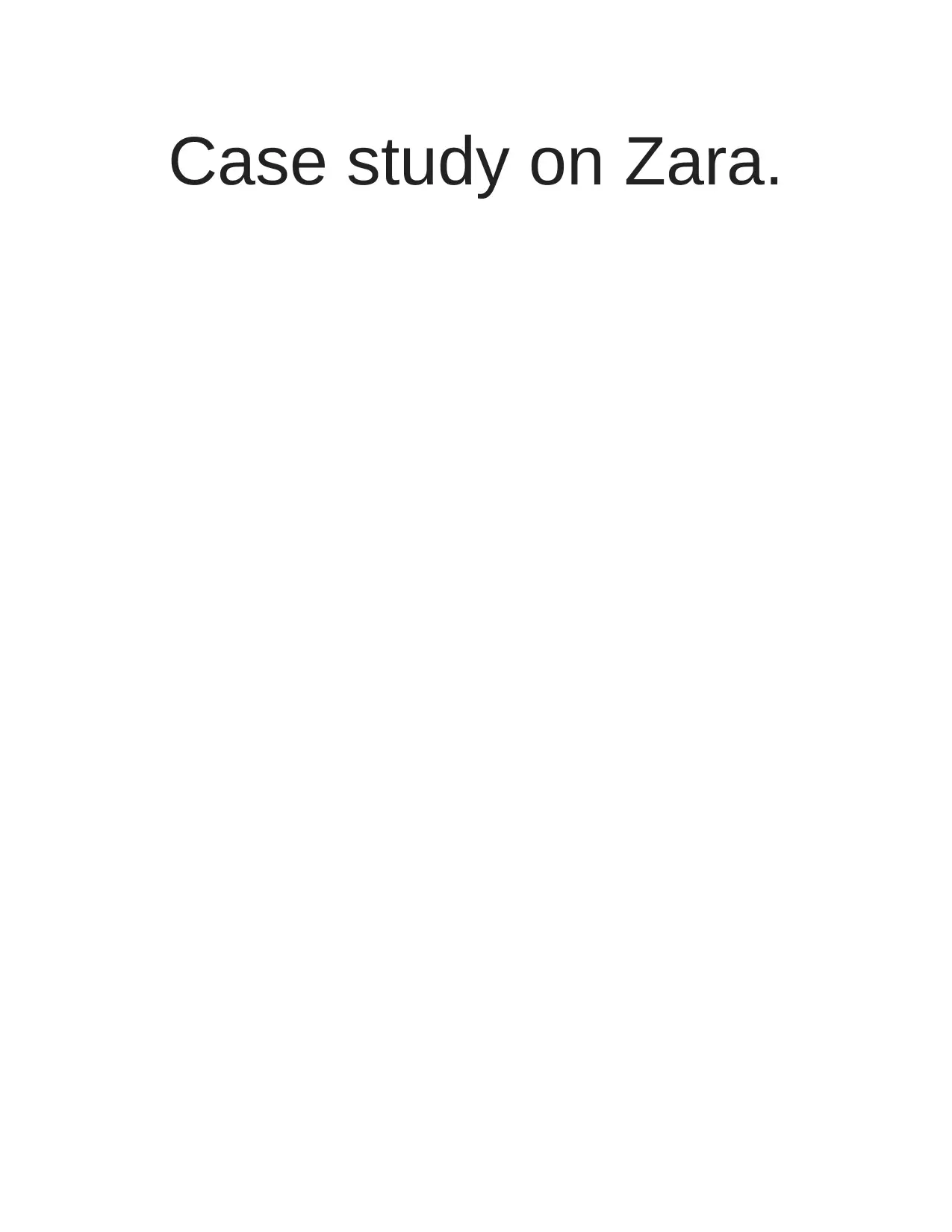
Case study on Zara.
Secure Best Marks with AI Grader
Need help grading? Try our AI Grader for instant feedback on your assignments.
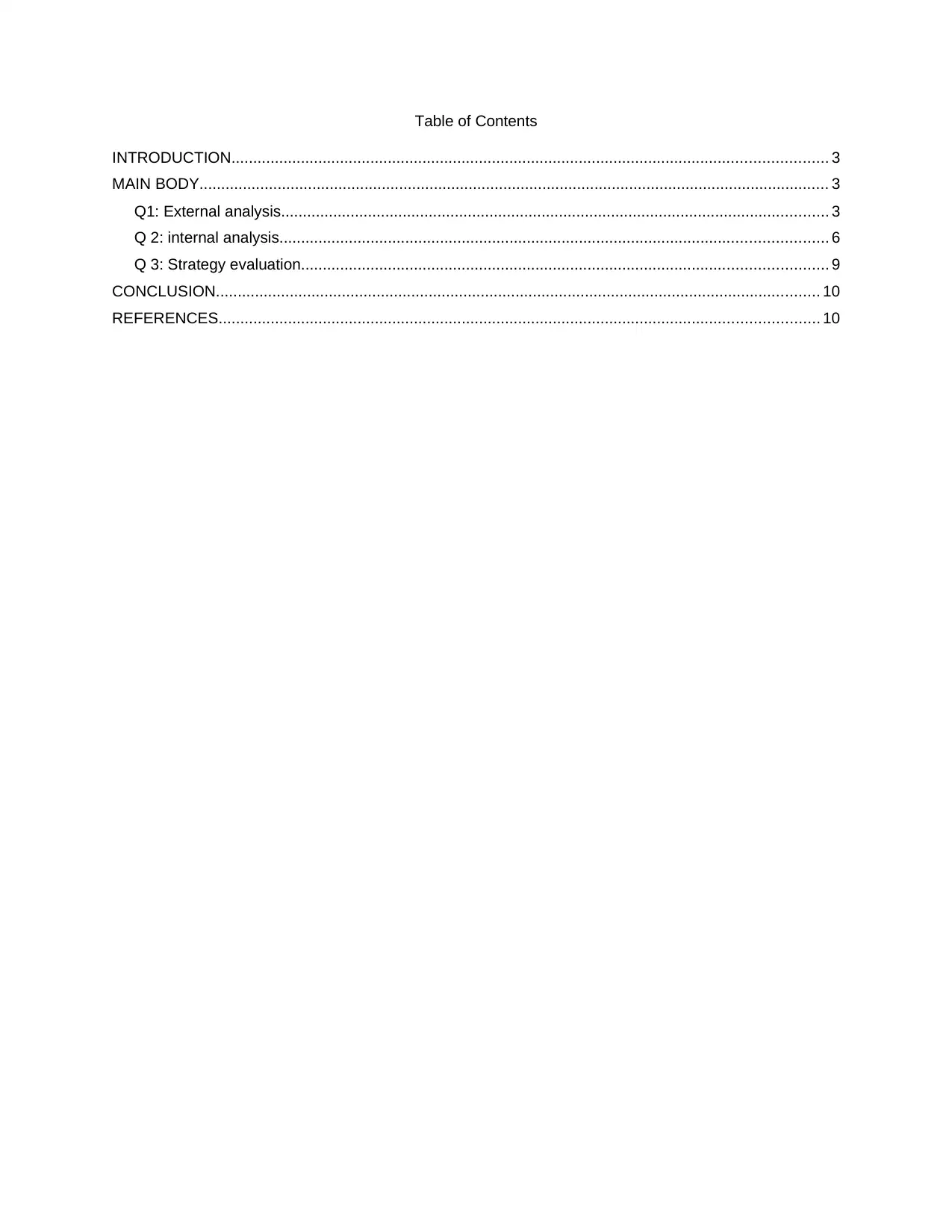
Table of Contents
INTRODUCTION......................................................................................................................................... 3
MAIN BODY................................................................................................................................................. 3
Q1: External analysis.............................................................................................................................. 3
Q 2: internal analysis.............................................................................................................................. 6
Q 3: Strategy evaluation......................................................................................................................... 9
CONCLUSION........................................................................................................................................... 10
REFERENCES.......................................................................................................................................... 10
INTRODUCTION......................................................................................................................................... 3
MAIN BODY................................................................................................................................................. 3
Q1: External analysis.............................................................................................................................. 3
Q 2: internal analysis.............................................................................................................................. 6
Q 3: Strategy evaluation......................................................................................................................... 9
CONCLUSION........................................................................................................................................... 10
REFERENCES.......................................................................................................................................... 10
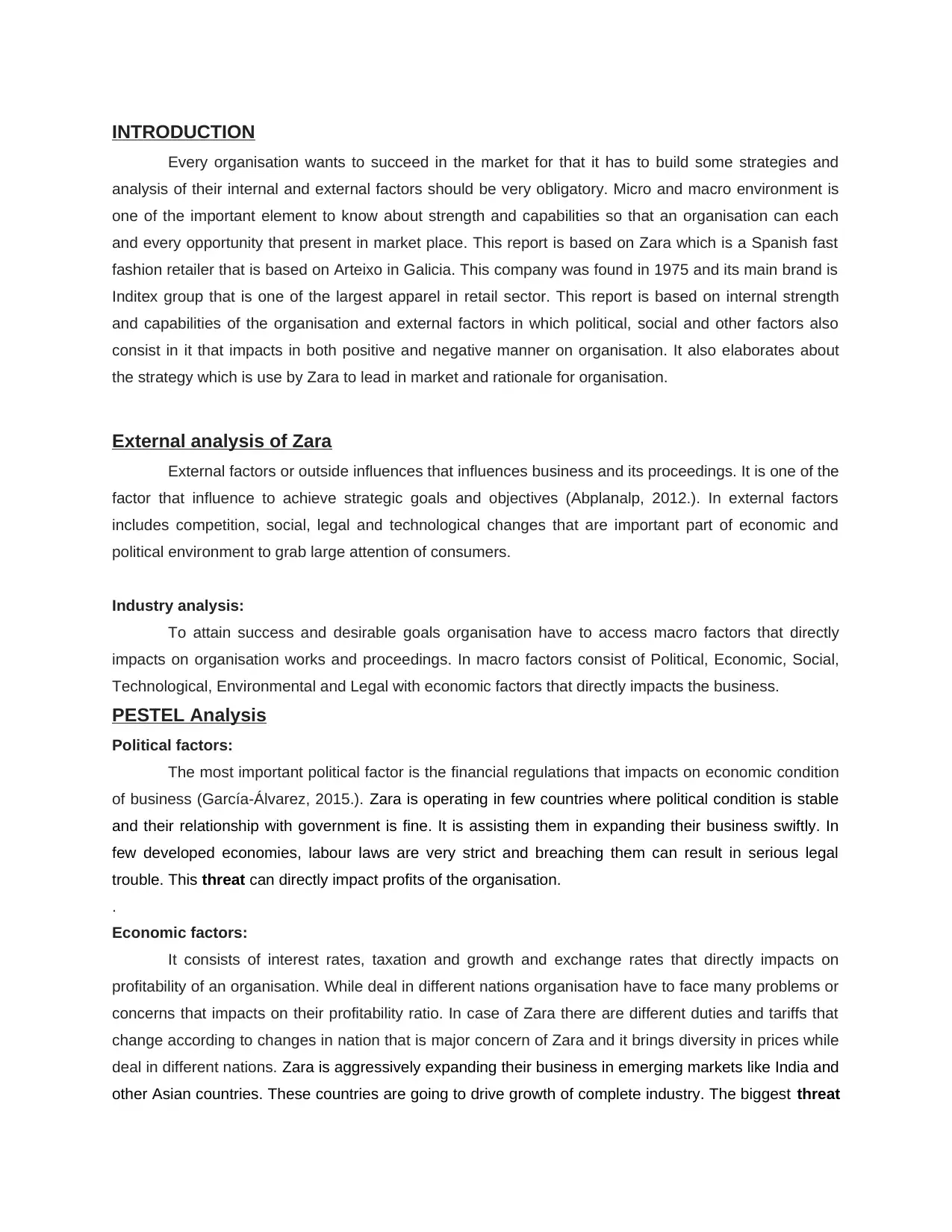
INTRODUCTION
Every organisation wants to succeed in the market for that it has to build some strategies and
analysis of their internal and external factors should be very obligatory. Micro and macro environment is
one of the important element to know about strength and capabilities so that an organisation can each
and every opportunity that present in market place. This report is based on Zara which is a Spanish fast
fashion retailer that is based on Arteixo in Galicia. This company was found in 1975 and its main brand is
Inditex group that is one of the largest apparel in retail sector. This report is based on internal strength
and capabilities of the organisation and external factors in which political, social and other factors also
consist in it that impacts in both positive and negative manner on organisation. It also elaborates about
the strategy which is use by Zara to lead in market and rationale for organisation.
External analysis of Zara
External factors or outside influences that influences business and its proceedings. It is one of the
factor that influence to achieve strategic goals and objectives (Abplanalp, 2012.). In external factors
includes competition, social, legal and technological changes that are important part of economic and
political environment to grab large attention of consumers.
Industry analysis:
To attain success and desirable goals organisation have to access macro factors that directly
impacts on organisation works and proceedings. In macro factors consist of Political, Economic, Social,
Technological, Environmental and Legal with economic factors that directly impacts the business.
PESTEL Analysis
Political factors:
The most important political factor is the financial regulations that impacts on economic condition
of business (García-Álvarez, 2015.). Zara is operating in few countries where political condition is stable
and their relationship with government is fine. It is assisting them in expanding their business swiftly. In
few developed economies, labour laws are very strict and breaching them can result in serious legal
trouble. This threat can directly impact profits of the organisation.
.
Economic factors:
It consists of interest rates, taxation and growth and exchange rates that directly impacts on
profitability of an organisation. While deal in different nations organisation have to face many problems or
concerns that impacts on their profitability ratio. In case of Zara there are different duties and tariffs that
change according to changes in nation that is major concern of Zara and it brings diversity in prices while
deal in different nations. Zara is aggressively expanding their business in emerging markets like India and
other Asian countries. These countries are going to drive growth of complete industry. The biggest threat
Every organisation wants to succeed in the market for that it has to build some strategies and
analysis of their internal and external factors should be very obligatory. Micro and macro environment is
one of the important element to know about strength and capabilities so that an organisation can each
and every opportunity that present in market place. This report is based on Zara which is a Spanish fast
fashion retailer that is based on Arteixo in Galicia. This company was found in 1975 and its main brand is
Inditex group that is one of the largest apparel in retail sector. This report is based on internal strength
and capabilities of the organisation and external factors in which political, social and other factors also
consist in it that impacts in both positive and negative manner on organisation. It also elaborates about
the strategy which is use by Zara to lead in market and rationale for organisation.
External analysis of Zara
External factors or outside influences that influences business and its proceedings. It is one of the
factor that influence to achieve strategic goals and objectives (Abplanalp, 2012.). In external factors
includes competition, social, legal and technological changes that are important part of economic and
political environment to grab large attention of consumers.
Industry analysis:
To attain success and desirable goals organisation have to access macro factors that directly
impacts on organisation works and proceedings. In macro factors consist of Political, Economic, Social,
Technological, Environmental and Legal with economic factors that directly impacts the business.
PESTEL Analysis
Political factors:
The most important political factor is the financial regulations that impacts on economic condition
of business (García-Álvarez, 2015.). Zara is operating in few countries where political condition is stable
and their relationship with government is fine. It is assisting them in expanding their business swiftly. In
few developed economies, labour laws are very strict and breaching them can result in serious legal
trouble. This threat can directly impact profits of the organisation.
.
Economic factors:
It consists of interest rates, taxation and growth and exchange rates that directly impacts on
profitability of an organisation. While deal in different nations organisation have to face many problems or
concerns that impacts on their profitability ratio. In case of Zara there are different duties and tariffs that
change according to changes in nation that is major concern of Zara and it brings diversity in prices while
deal in different nations. Zara is aggressively expanding their business in emerging markets like India and
other Asian countries. These countries are going to drive growth of complete industry. The biggest threat
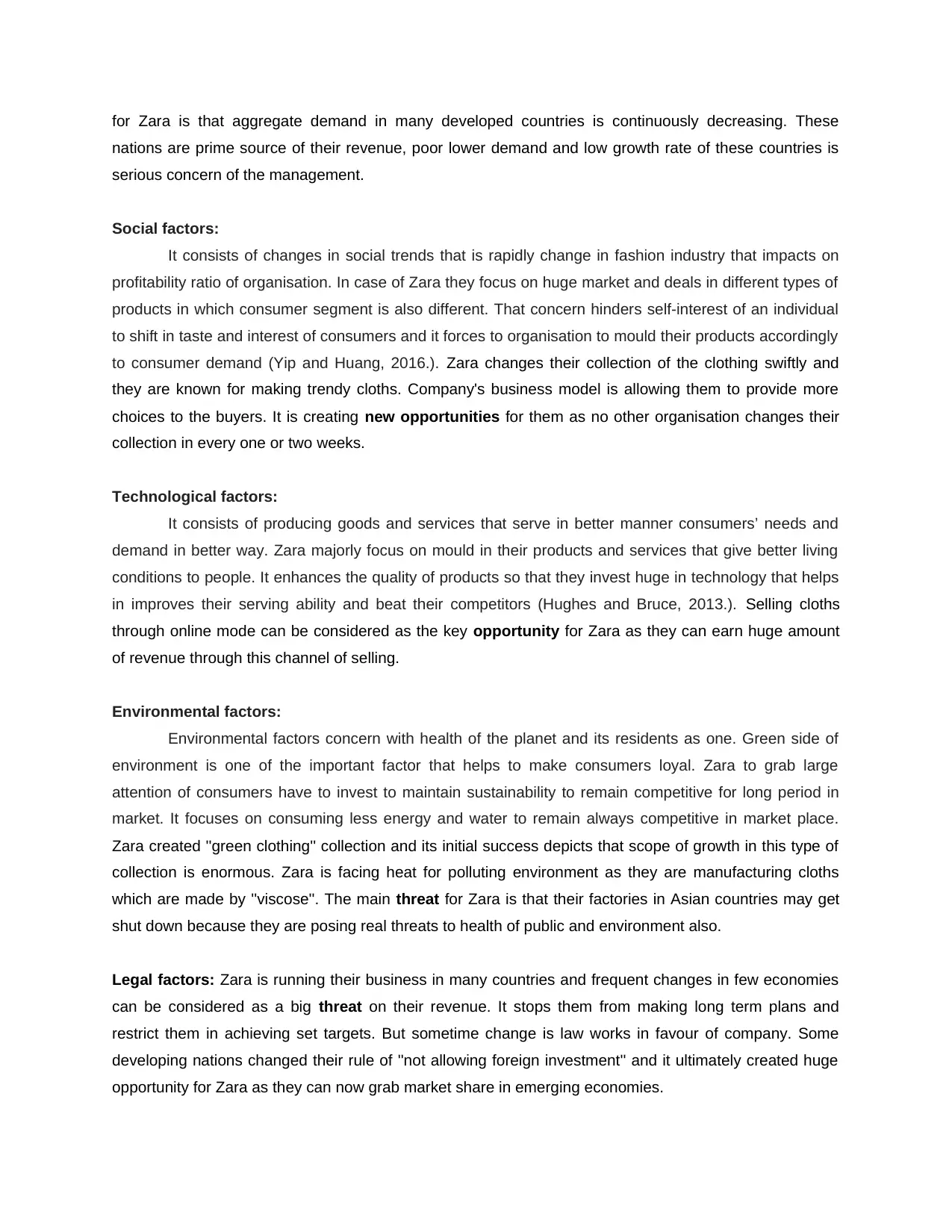
for Zara is that aggregate demand in many developed countries is continuously decreasing. These
nations are prime source of their revenue, poor lower demand and low growth rate of these countries is
serious concern of the management.
Social factors:
It consists of changes in social trends that is rapidly change in fashion industry that impacts on
profitability ratio of organisation. In case of Zara they focus on huge market and deals in different types of
products in which consumer segment is also different. That concern hinders self-interest of an individual
to shift in taste and interest of consumers and it forces to organisation to mould their products accordingly
to consumer demand (Yip and Huang, 2016.). Zara changes their collection of the clothing swiftly and
they are known for making trendy cloths. Company's business model is allowing them to provide more
choices to the buyers. It is creating new opportunities for them as no other organisation changes their
collection in every one or two weeks.
Technological factors:
It consists of producing goods and services that serve in better manner consumers’ needs and
demand in better way. Zara majorly focus on mould in their products and services that give better living
conditions to people. It enhances the quality of products so that they invest huge in technology that helps
in improves their serving ability and beat their competitors (Hughes and Bruce, 2013.). Selling cloths
through online mode can be considered as the key opportunity for Zara as they can earn huge amount
of revenue through this channel of selling.
Environmental factors:
Environmental factors concern with health of the planet and its residents as one. Green side of
environment is one of the important factor that helps to make consumers loyal. Zara to grab large
attention of consumers have to invest to maintain sustainability to remain competitive for long period in
market. It focuses on consuming less energy and water to remain always competitive in market place.
Zara created ''green clothing'' collection and its initial success depicts that scope of growth in this type of
collection is enormous. Zara is facing heat for polluting environment as they are manufacturing cloths
which are made by ''viscose''. The main threat for Zara is that their factories in Asian countries may get
shut down because they are posing real threats to health of public and environment also.
Legal factors: Zara is running their business in many countries and frequent changes in few economies
can be considered as a big threat on their revenue. It stops them from making long term plans and
restrict them in achieving set targets. But sometime change is law works in favour of company. Some
developing nations changed their rule of ''not allowing foreign investment'' and it ultimately created huge
opportunity for Zara as they can now grab market share in emerging economies.
nations are prime source of their revenue, poor lower demand and low growth rate of these countries is
serious concern of the management.
Social factors:
It consists of changes in social trends that is rapidly change in fashion industry that impacts on
profitability ratio of organisation. In case of Zara they focus on huge market and deals in different types of
products in which consumer segment is also different. That concern hinders self-interest of an individual
to shift in taste and interest of consumers and it forces to organisation to mould their products accordingly
to consumer demand (Yip and Huang, 2016.). Zara changes their collection of the clothing swiftly and
they are known for making trendy cloths. Company's business model is allowing them to provide more
choices to the buyers. It is creating new opportunities for them as no other organisation changes their
collection in every one or two weeks.
Technological factors:
It consists of producing goods and services that serve in better manner consumers’ needs and
demand in better way. Zara majorly focus on mould in their products and services that give better living
conditions to people. It enhances the quality of products so that they invest huge in technology that helps
in improves their serving ability and beat their competitors (Hughes and Bruce, 2013.). Selling cloths
through online mode can be considered as the key opportunity for Zara as they can earn huge amount
of revenue through this channel of selling.
Environmental factors:
Environmental factors concern with health of the planet and its residents as one. Green side of
environment is one of the important factor that helps to make consumers loyal. Zara to grab large
attention of consumers have to invest to maintain sustainability to remain competitive for long period in
market. It focuses on consuming less energy and water to remain always competitive in market place.
Zara created ''green clothing'' collection and its initial success depicts that scope of growth in this type of
collection is enormous. Zara is facing heat for polluting environment as they are manufacturing cloths
which are made by ''viscose''. The main threat for Zara is that their factories in Asian countries may get
shut down because they are posing real threats to health of public and environment also.
Legal factors: Zara is running their business in many countries and frequent changes in few economies
can be considered as a big threat on their revenue. It stops them from making long term plans and
restrict them in achieving set targets. But sometime change is law works in favour of company. Some
developing nations changed their rule of ''not allowing foreign investment'' and it ultimately created huge
opportunity for Zara as they can now grab market share in emerging economies.
Secure Best Marks with AI Grader
Need help grading? Try our AI Grader for instant feedback on your assignments.
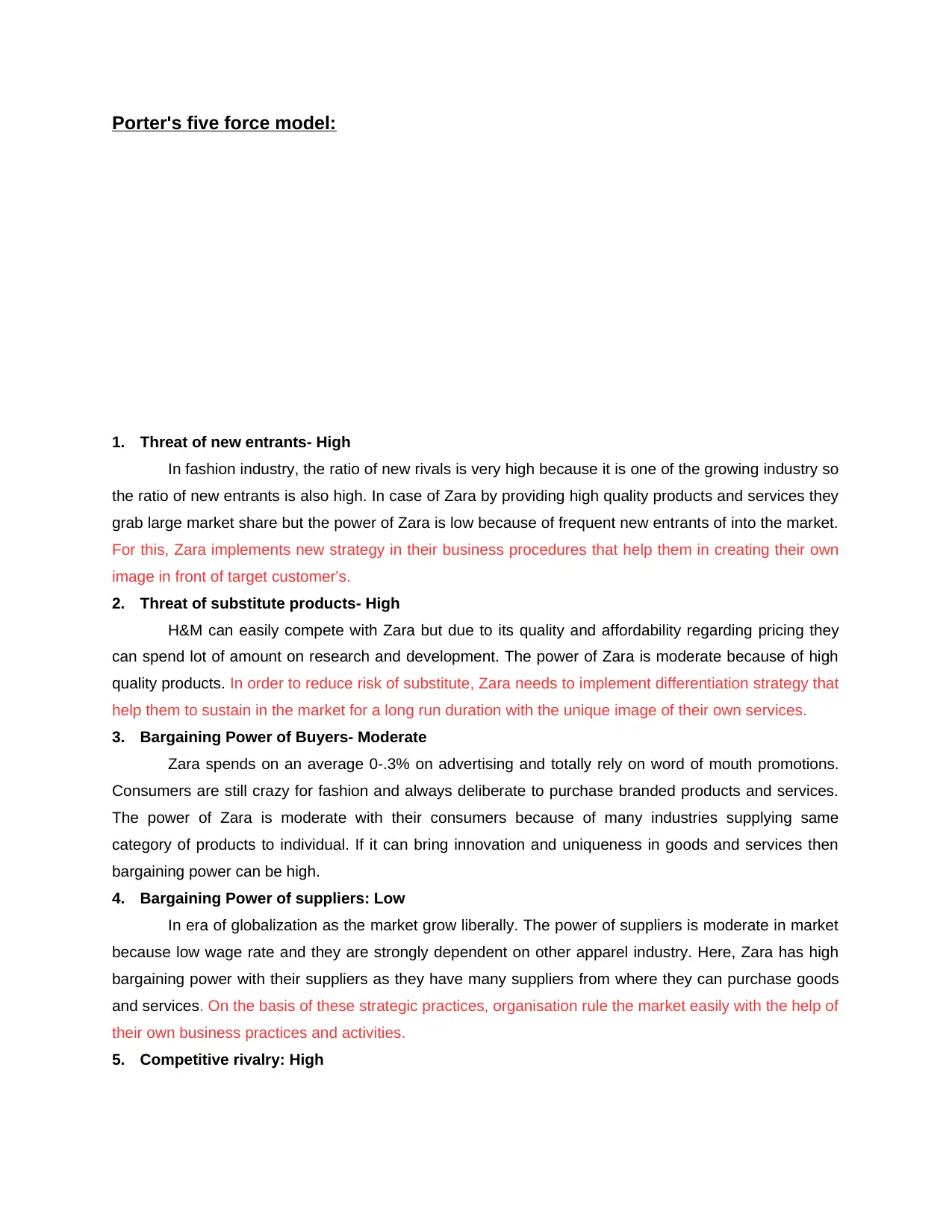
Porter's five force model:
1. Threat of new entrants- High
In fashion industry, the ratio of new rivals is very high because it is one of the growing industry so
the ratio of new entrants is also high. In case of Zara by providing high quality products and services they
grab large market share but the power of Zara is low because of frequent new entrants of into the market.
For this, Zara implements new strategy in their business procedures that help them in creating their own
image in front of target customer's.
2. Threat of substitute products- High
H&M can easily compete with Zara but due to its quality and affordability regarding pricing they
can spend lot of amount on research and development. The power of Zara is moderate because of high
quality products. In order to reduce risk of substitute, Zara needs to implement differentiation strategy that
help them to sustain in the market for a long run duration with the unique image of their own services.
3. Bargaining Power of Buyers- Moderate
Zara spends on an average 0-.3% on advertising and totally rely on word of mouth promotions.
Consumers are still crazy for fashion and always deliberate to purchase branded products and services.
The power of Zara is moderate with their consumers because of many industries supplying same
category of products to individual. If it can bring innovation and uniqueness in goods and services then
bargaining power can be high.
4. Bargaining Power of suppliers: Low
In era of globalization as the market grow liberally. The power of suppliers is moderate in market
because low wage rate and they are strongly dependent on other apparel industry. Here, Zara has high
bargaining power with their suppliers as they have many suppliers from where they can purchase goods
and services. On the basis of these strategic practices, organisation rule the market easily with the help of
their own business practices and activities.
5. Competitive rivalry: High
1. Threat of new entrants- High
In fashion industry, the ratio of new rivals is very high because it is one of the growing industry so
the ratio of new entrants is also high. In case of Zara by providing high quality products and services they
grab large market share but the power of Zara is low because of frequent new entrants of into the market.
For this, Zara implements new strategy in their business procedures that help them in creating their own
image in front of target customer's.
2. Threat of substitute products- High
H&M can easily compete with Zara but due to its quality and affordability regarding pricing they
can spend lot of amount on research and development. The power of Zara is moderate because of high
quality products. In order to reduce risk of substitute, Zara needs to implement differentiation strategy that
help them to sustain in the market for a long run duration with the unique image of their own services.
3. Bargaining Power of Buyers- Moderate
Zara spends on an average 0-.3% on advertising and totally rely on word of mouth promotions.
Consumers are still crazy for fashion and always deliberate to purchase branded products and services.
The power of Zara is moderate with their consumers because of many industries supplying same
category of products to individual. If it can bring innovation and uniqueness in goods and services then
bargaining power can be high.
4. Bargaining Power of suppliers: Low
In era of globalization as the market grow liberally. The power of suppliers is moderate in market
because low wage rate and they are strongly dependent on other apparel industry. Here, Zara has high
bargaining power with their suppliers as they have many suppliers from where they can purchase goods
and services. On the basis of these strategic practices, organisation rule the market easily with the help of
their own business practices and activities.
5. Competitive rivalry: High
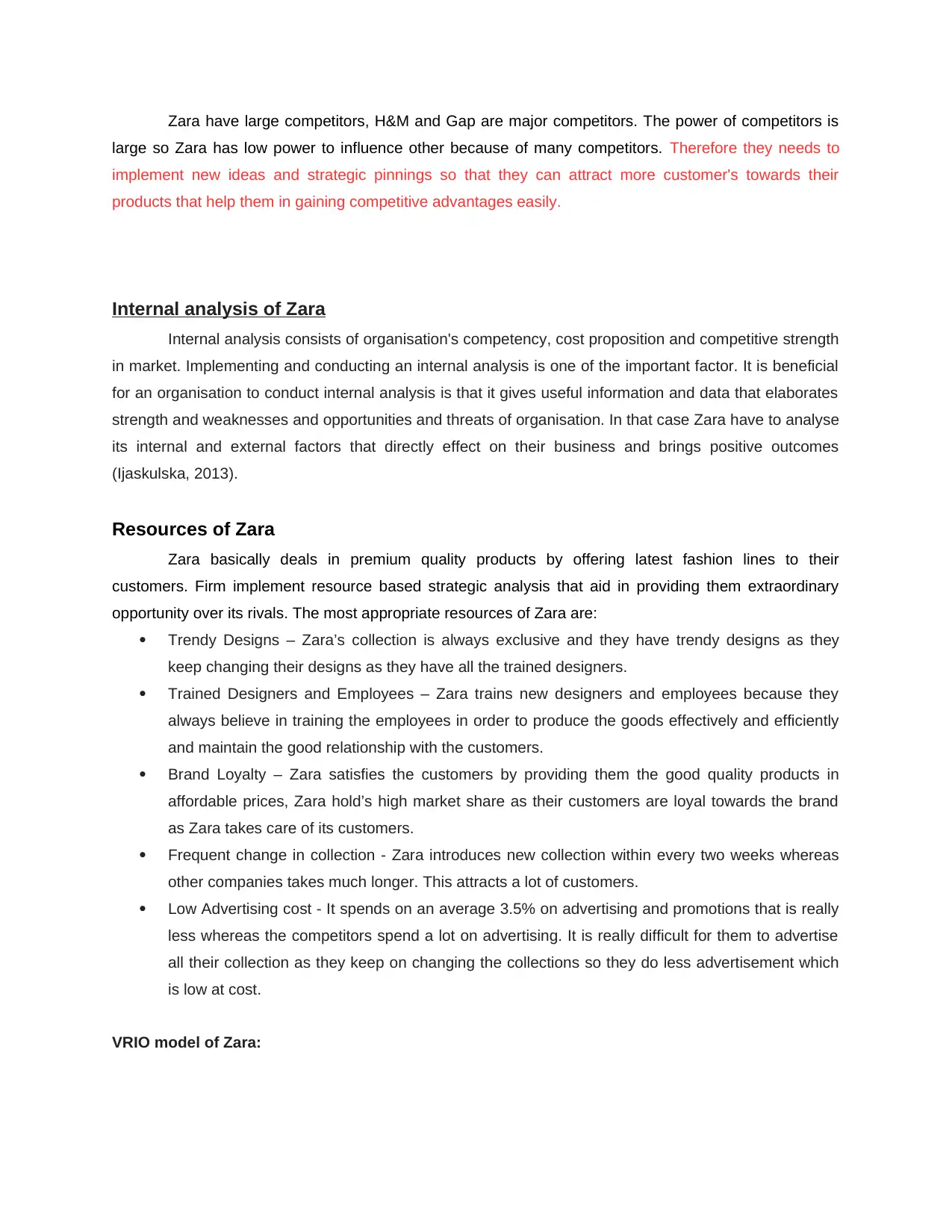
Zara have large competitors, H&M and Gap are major competitors. The power of competitors is
large so Zara has low power to influence other because of many competitors. Therefore they needs to
implement new ideas and strategic pinnings so that they can attract more customer's towards their
products that help them in gaining competitive advantages easily.
Internal analysis of Zara
Internal analysis consists of organisation's competency, cost proposition and competitive strength
in market. Implementing and conducting an internal analysis is one of the important factor. It is beneficial
for an organisation to conduct internal analysis is that it gives useful information and data that elaborates
strength and weaknesses and opportunities and threats of organisation. In that case Zara have to analyse
its internal and external factors that directly effect on their business and brings positive outcomes
(Ijaskulska, 2013).
Resources of Zara
Zara basically deals in premium quality products by offering latest fashion lines to their
customers. Firm implement resource based strategic analysis that aid in providing them extraordinary
opportunity over its rivals. The most appropriate resources of Zara are:
Trendy Designs – Zara’s collection is always exclusive and they have trendy designs as they
keep changing their designs as they have all the trained designers.
Trained Designers and Employees – Zara trains new designers and employees because they
always believe in training the employees in order to produce the goods effectively and efficiently
and maintain the good relationship with the customers.
Brand Loyalty – Zara satisfies the customers by providing them the good quality products in
affordable prices, Zara hold’s high market share as their customers are loyal towards the brand
as Zara takes care of its customers.
Frequent change in collection - Zara introduces new collection within every two weeks whereas
other companies takes much longer. This attracts a lot of customers.
Low Advertising cost - It spends on an average 3.5% on advertising and promotions that is really
less whereas the competitors spend a lot on advertising. It is really difficult for them to advertise
all their collection as they keep on changing the collections so they do less advertisement which
is low at cost.
VRIO model of Zara:
large so Zara has low power to influence other because of many competitors. Therefore they needs to
implement new ideas and strategic pinnings so that they can attract more customer's towards their
products that help them in gaining competitive advantages easily.
Internal analysis of Zara
Internal analysis consists of organisation's competency, cost proposition and competitive strength
in market. Implementing and conducting an internal analysis is one of the important factor. It is beneficial
for an organisation to conduct internal analysis is that it gives useful information and data that elaborates
strength and weaknesses and opportunities and threats of organisation. In that case Zara have to analyse
its internal and external factors that directly effect on their business and brings positive outcomes
(Ijaskulska, 2013).
Resources of Zara
Zara basically deals in premium quality products by offering latest fashion lines to their
customers. Firm implement resource based strategic analysis that aid in providing them extraordinary
opportunity over its rivals. The most appropriate resources of Zara are:
Trendy Designs – Zara’s collection is always exclusive and they have trendy designs as they
keep changing their designs as they have all the trained designers.
Trained Designers and Employees – Zara trains new designers and employees because they
always believe in training the employees in order to produce the goods effectively and efficiently
and maintain the good relationship with the customers.
Brand Loyalty – Zara satisfies the customers by providing them the good quality products in
affordable prices, Zara hold’s high market share as their customers are loyal towards the brand
as Zara takes care of its customers.
Frequent change in collection - Zara introduces new collection within every two weeks whereas
other companies takes much longer. This attracts a lot of customers.
Low Advertising cost - It spends on an average 3.5% on advertising and promotions that is really
less whereas the competitors spend a lot on advertising. It is really difficult for them to advertise
all their collection as they keep on changing the collections so they do less advertisement which
is low at cost.
VRIO model of Zara:
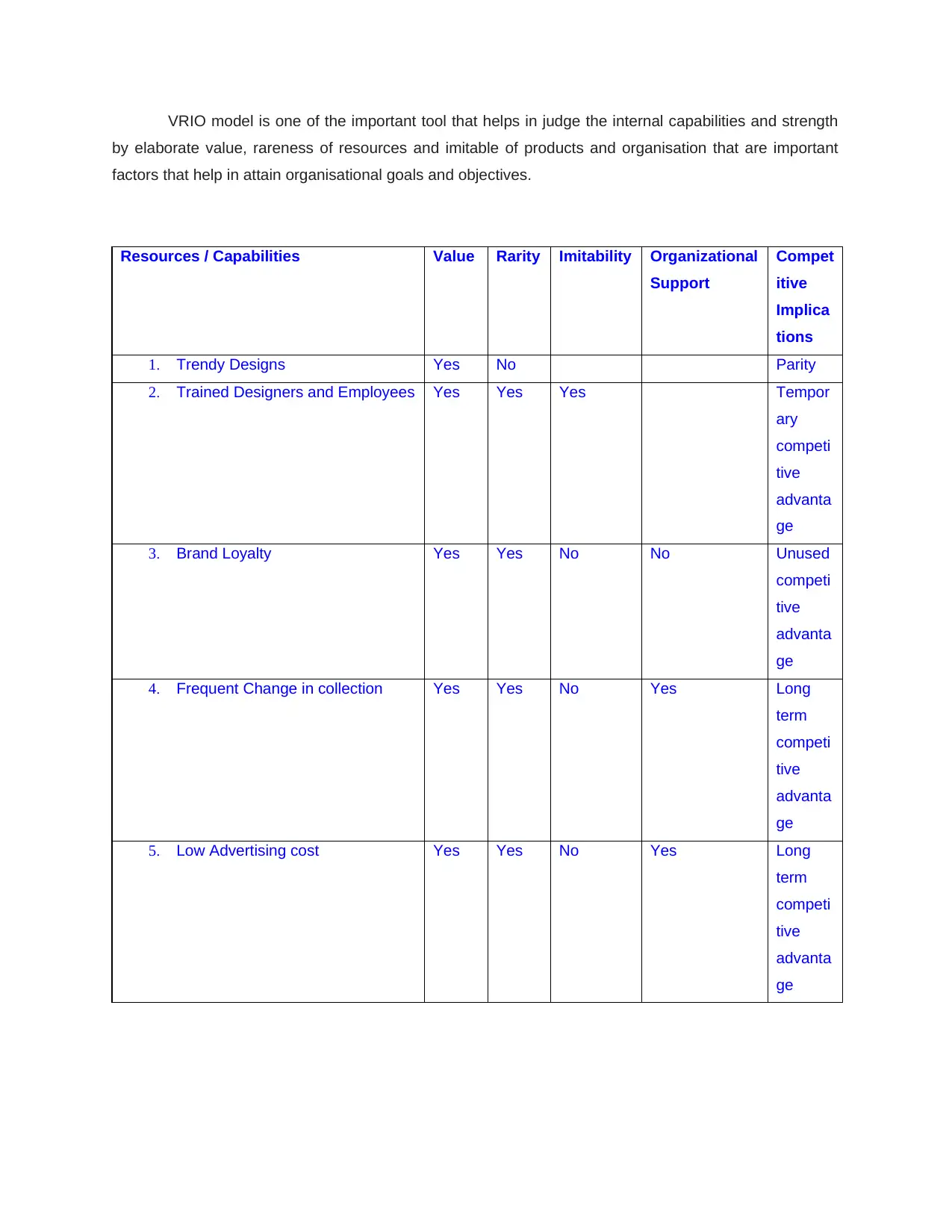
VRIO model is one of the important tool that helps in judge the internal capabilities and strength
by elaborate value, rareness of resources and imitable of products and organisation that are important
factors that help in attain organisational goals and objectives.
Resources / Capabilities Value Rarity Imitability Organizational
Support
Compet
itive
Implica
tions
1. Trendy Designs Yes No Parity
2. Trained Designers and Employees Yes Yes Yes Tempor
ary
competi
tive
advanta
ge
3. Brand Loyalty Yes Yes No No Unused
competi
tive
advanta
ge
4. Frequent Change in collection Yes Yes No Yes Long
term
competi
tive
advanta
ge
5. Low Advertising cost Yes Yes No Yes Long
term
competi
tive
advanta
ge
by elaborate value, rareness of resources and imitable of products and organisation that are important
factors that help in attain organisational goals and objectives.
Resources / Capabilities Value Rarity Imitability Organizational
Support
Compet
itive
Implica
tions
1. Trendy Designs Yes No Parity
2. Trained Designers and Employees Yes Yes Yes Tempor
ary
competi
tive
advanta
ge
3. Brand Loyalty Yes Yes No No Unused
competi
tive
advanta
ge
4. Frequent Change in collection Yes Yes No Yes Long
term
competi
tive
advanta
ge
5. Low Advertising cost Yes Yes No Yes Long
term
competi
tive
advanta
ge
Paraphrase This Document
Need a fresh take? Get an instant paraphrase of this document with our AI Paraphraser
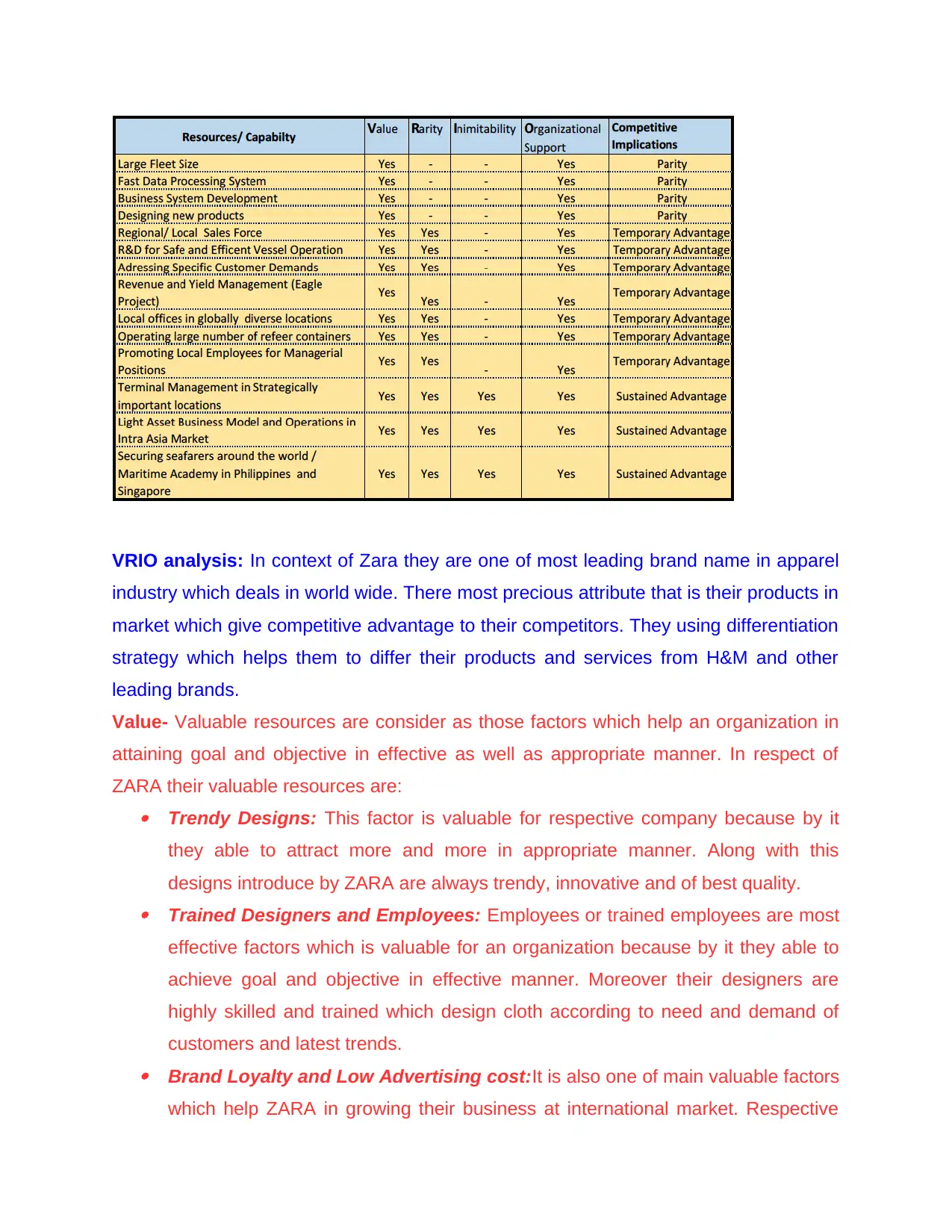
VRIO analysis: In context of Zara they are one of most leading brand name in apparel
industry which deals in world wide. There most precious attribute that is their products in
market which give competitive advantage to their competitors. They using differentiation
strategy which helps them to differ their products and services from H&M and other
leading brands.
Value- Valuable resources are consider as those factors which help an organization in
attaining goal and objective in effective as well as appropriate manner. In respect of
ZARA their valuable resources are: Trendy Designs: This factor is valuable for respective company because by it
they able to attract more and more in appropriate manner. Along with this
designs introduce by ZARA are always trendy, innovative and of best quality. Trained Designers and Employees: Employees or trained employees are most
effective factors which is valuable for an organization because by it they able to
achieve goal and objective in effective manner. Moreover their designers are
highly skilled and trained which design cloth according to need and demand of
customers and latest trends. Brand Loyalty and Low Advertising cost:It is also one of main valuable factors
which help ZARA in growing their business at international market. Respective
industry which deals in world wide. There most precious attribute that is their products in
market which give competitive advantage to their competitors. They using differentiation
strategy which helps them to differ their products and services from H&M and other
leading brands.
Value- Valuable resources are consider as those factors which help an organization in
attaining goal and objective in effective as well as appropriate manner. In respect of
ZARA their valuable resources are: Trendy Designs: This factor is valuable for respective company because by it
they able to attract more and more in appropriate manner. Along with this
designs introduce by ZARA are always trendy, innovative and of best quality. Trained Designers and Employees: Employees or trained employees are most
effective factors which is valuable for an organization because by it they able to
achieve goal and objective in effective manner. Moreover their designers are
highly skilled and trained which design cloth according to need and demand of
customers and latest trends. Brand Loyalty and Low Advertising cost:It is also one of main valuable factors
which help ZARA in growing their business at international market. Respective
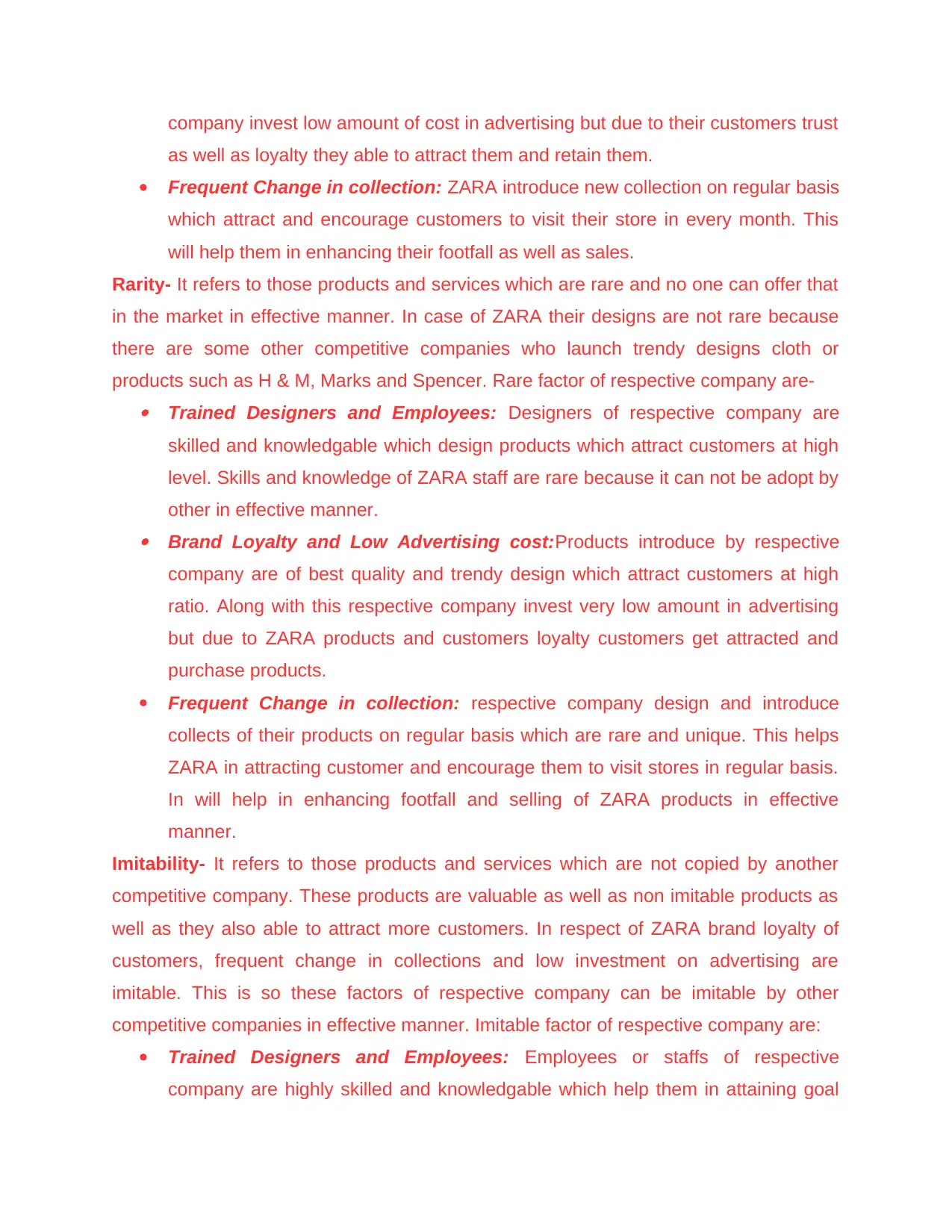
company invest low amount of cost in advertising but due to their customers trust
as well as loyalty they able to attract them and retain them.
Frequent Change in collection: ZARA introduce new collection on regular basis
which attract and encourage customers to visit their store in every month. This
will help them in enhancing their footfall as well as sales.
Rarity- It refers to those products and services which are rare and no one can offer that
in the market in effective manner. In case of ZARA their designs are not rare because
there are some other competitive companies who launch trendy designs cloth or
products such as H & M, Marks and Spencer. Rare factor of respective company are- Trained Designers and Employees: Designers of respective company are
skilled and knowledgable which design products which attract customers at high
level. Skills and knowledge of ZARA staff are rare because it can not be adopt by
other in effective manner. Brand Loyalty and Low Advertising cost:Products introduce by respective
company are of best quality and trendy design which attract customers at high
ratio. Along with this respective company invest very low amount in advertising
but due to ZARA products and customers loyalty customers get attracted and
purchase products.
Frequent Change in collection: respective company design and introduce
collects of their products on regular basis which are rare and unique. This helps
ZARA in attracting customer and encourage them to visit stores in regular basis.
In will help in enhancing footfall and selling of ZARA products in effective
manner.
Imitability- It refers to those products and services which are not copied by another
competitive company. These products are valuable as well as non imitable products as
well as they also able to attract more customers. In respect of ZARA brand loyalty of
customers, frequent change in collections and low investment on advertising are
imitable. This is so these factors of respective company can be imitable by other
competitive companies in effective manner. Imitable factor of respective company are:
Trained Designers and Employees: Employees or staffs of respective
company are highly skilled and knowledgable which help them in attaining goal
as well as loyalty they able to attract them and retain them.
Frequent Change in collection: ZARA introduce new collection on regular basis
which attract and encourage customers to visit their store in every month. This
will help them in enhancing their footfall as well as sales.
Rarity- It refers to those products and services which are rare and no one can offer that
in the market in effective manner. In case of ZARA their designs are not rare because
there are some other competitive companies who launch trendy designs cloth or
products such as H & M, Marks and Spencer. Rare factor of respective company are- Trained Designers and Employees: Designers of respective company are
skilled and knowledgable which design products which attract customers at high
level. Skills and knowledge of ZARA staff are rare because it can not be adopt by
other in effective manner. Brand Loyalty and Low Advertising cost:Products introduce by respective
company are of best quality and trendy design which attract customers at high
ratio. Along with this respective company invest very low amount in advertising
but due to ZARA products and customers loyalty customers get attracted and
purchase products.
Frequent Change in collection: respective company design and introduce
collects of their products on regular basis which are rare and unique. This helps
ZARA in attracting customer and encourage them to visit stores in regular basis.
In will help in enhancing footfall and selling of ZARA products in effective
manner.
Imitability- It refers to those products and services which are not copied by another
competitive company. These products are valuable as well as non imitable products as
well as they also able to attract more customers. In respect of ZARA brand loyalty of
customers, frequent change in collections and low investment on advertising are
imitable. This is so these factors of respective company can be imitable by other
competitive companies in effective manner. Imitable factor of respective company are:
Trained Designers and Employees: Employees or staffs of respective
company are highly skilled and knowledgable which help them in attaining goal
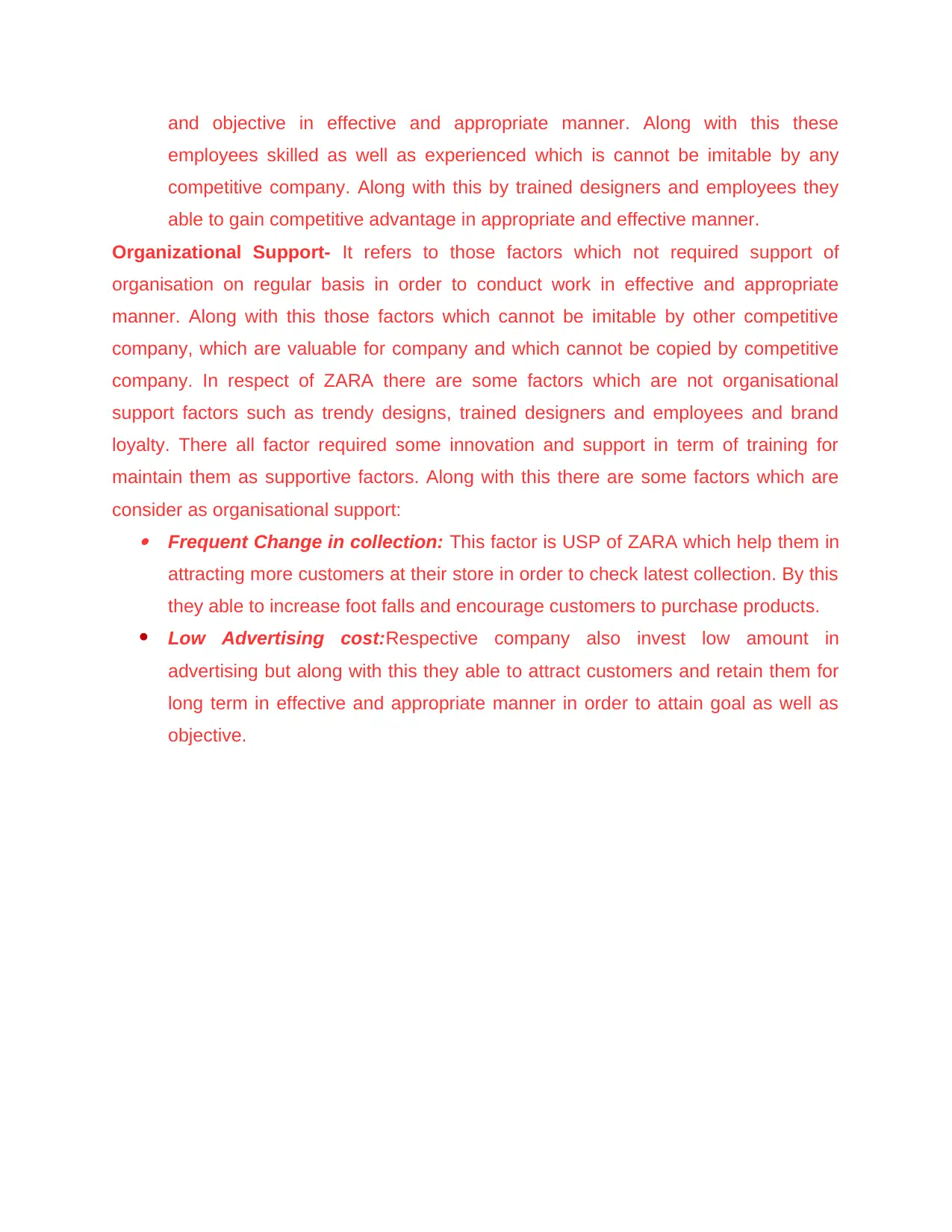
and objective in effective and appropriate manner. Along with this these
employees skilled as well as experienced which is cannot be imitable by any
competitive company. Along with this by trained designers and employees they
able to gain competitive advantage in appropriate and effective manner.
Organizational Support- It refers to those factors which not required support of
organisation on regular basis in order to conduct work in effective and appropriate
manner. Along with this those factors which cannot be imitable by other competitive
company, which are valuable for company and which cannot be copied by competitive
company. In respect of ZARA there are some factors which are not organisational
support factors such as trendy designs, trained designers and employees and brand
loyalty. There all factor required some innovation and support in term of training for
maintain them as supportive factors. Along with this there are some factors which are
consider as organisational support: Frequent Change in collection: This factor is USP of ZARA which help them in
attracting more customers at their store in order to check latest collection. By this
they able to increase foot falls and encourage customers to purchase products.
Low Advertising cost:Respective company also invest low amount in
advertising but along with this they able to attract customers and retain them for
long term in effective and appropriate manner in order to attain goal as well as
objective.
employees skilled as well as experienced which is cannot be imitable by any
competitive company. Along with this by trained designers and employees they
able to gain competitive advantage in appropriate and effective manner.
Organizational Support- It refers to those factors which not required support of
organisation on regular basis in order to conduct work in effective and appropriate
manner. Along with this those factors which cannot be imitable by other competitive
company, which are valuable for company and which cannot be copied by competitive
company. In respect of ZARA there are some factors which are not organisational
support factors such as trendy designs, trained designers and employees and brand
loyalty. There all factor required some innovation and support in term of training for
maintain them as supportive factors. Along with this there are some factors which are
consider as organisational support: Frequent Change in collection: This factor is USP of ZARA which help them in
attracting more customers at their store in order to check latest collection. By this
they able to increase foot falls and encourage customers to purchase products.
Low Advertising cost:Respective company also invest low amount in
advertising but along with this they able to attract customers and retain them for
long term in effective and appropriate manner in order to attain goal as well as
objective.
Secure Best Marks with AI Grader
Need help grading? Try our AI Grader for instant feedback on your assignments.
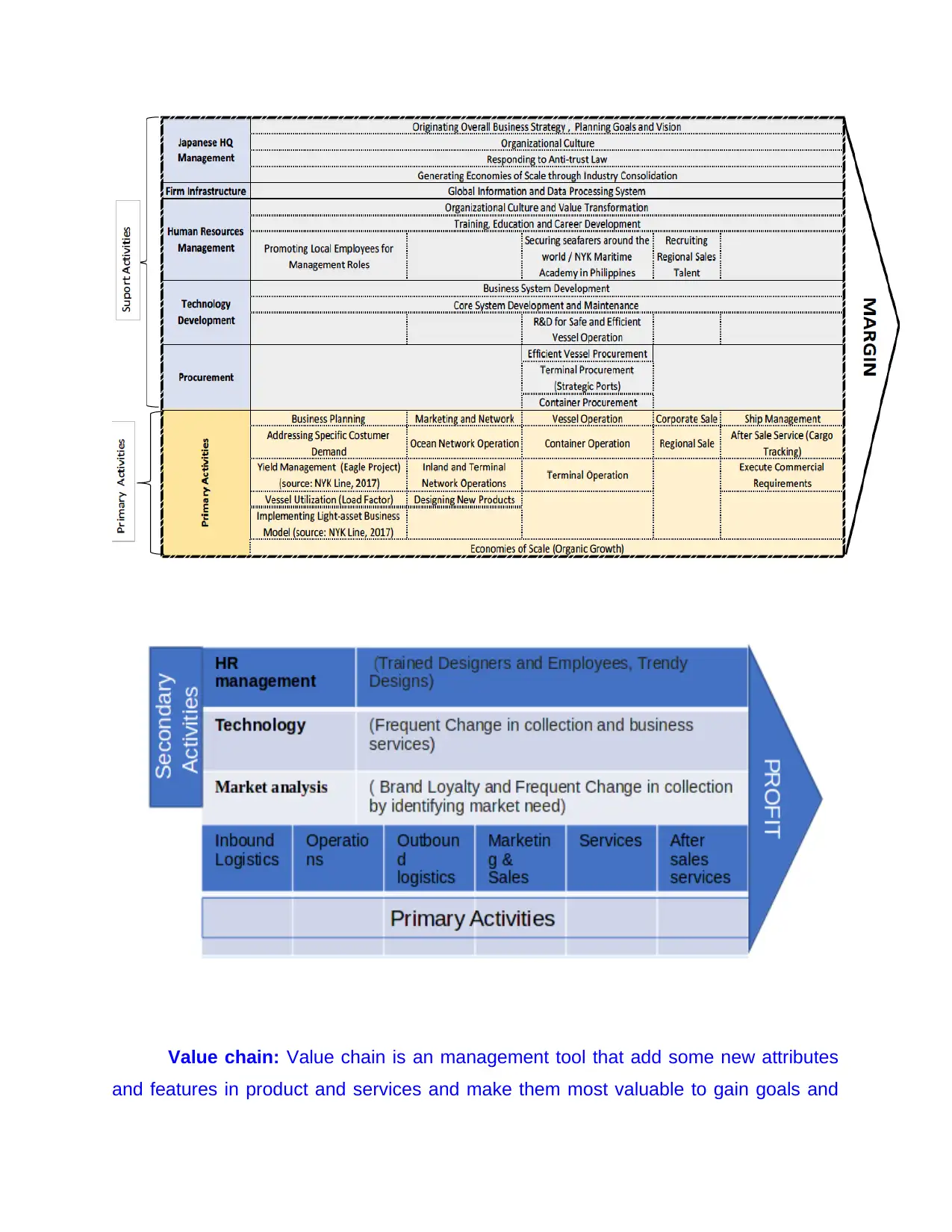
Value chain: Value chain is an management tool that add some new attributes
and features in product and services and make them most valuable to gain goals and
and features in product and services and make them most valuable to gain goals and
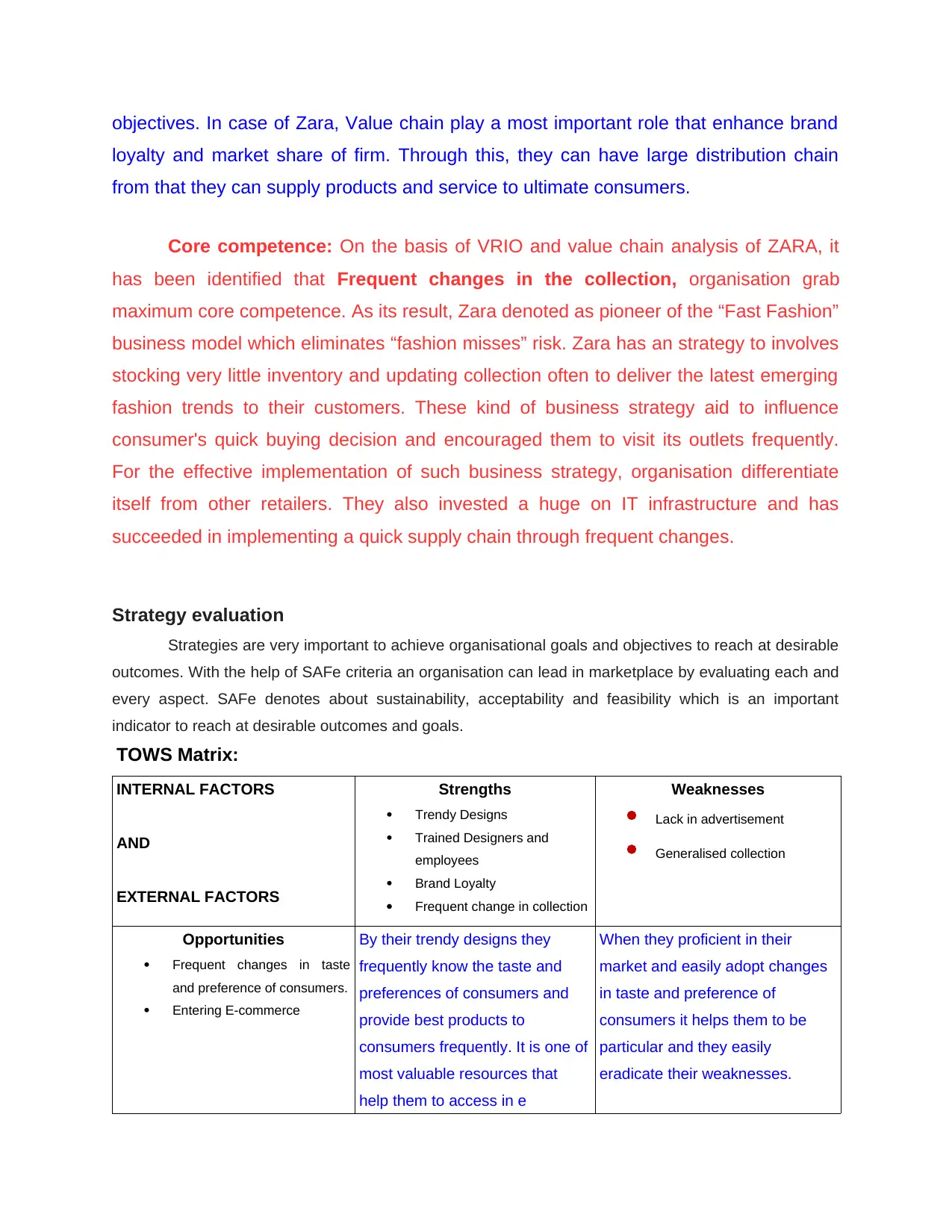
objectives. In case of Zara, Value chain play a most important role that enhance brand
loyalty and market share of firm. Through this, they can have large distribution chain
from that they can supply products and service to ultimate consumers.
Core competence: On the basis of VRIO and value chain analysis of ZARA, it
has been identified that Frequent changes in the collection, organisation grab
maximum core competence. As its result, Zara denoted as pioneer of the “Fast Fashion”
business model which eliminates “fashion misses” risk. Zara has an strategy to involves
stocking very little inventory and updating collection often to deliver the latest emerging
fashion trends to their customers. These kind of business strategy aid to influence
consumer's quick buying decision and encouraged them to visit its outlets frequently.
For the effective implementation of such business strategy, organisation differentiate
itself from other retailers. They also invested a huge on IT infrastructure and has
succeeded in implementing a quick supply chain through frequent changes.
Strategy evaluation
Strategies are very important to achieve organisational goals and objectives to reach at desirable
outcomes. With the help of SAFe criteria an organisation can lead in marketplace by evaluating each and
every aspect. SAFe denotes about sustainability, acceptability and feasibility which is an important
indicator to reach at desirable outcomes and goals.
TOWS Matrix:
INTERNAL FACTORS
AND
EXTERNAL FACTORS
Strengths
Trendy Designs
Trained Designers and
employees
Brand Loyalty
Frequent change in collection
Weaknesses
Lack in advertisement
Generalised collection
Opportunities
Frequent changes in taste
and preference of consumers.
Entering E-commerce
By their trendy designs they
frequently know the taste and
preferences of consumers and
provide best products to
consumers frequently. It is one of
most valuable resources that
help them to access in e
When they proficient in their
market and easily adopt changes
in taste and preference of
consumers it helps them to be
particular and they easily
eradicate their weaknesses.
loyalty and market share of firm. Through this, they can have large distribution chain
from that they can supply products and service to ultimate consumers.
Core competence: On the basis of VRIO and value chain analysis of ZARA, it
has been identified that Frequent changes in the collection, organisation grab
maximum core competence. As its result, Zara denoted as pioneer of the “Fast Fashion”
business model which eliminates “fashion misses” risk. Zara has an strategy to involves
stocking very little inventory and updating collection often to deliver the latest emerging
fashion trends to their customers. These kind of business strategy aid to influence
consumer's quick buying decision and encouraged them to visit its outlets frequently.
For the effective implementation of such business strategy, organisation differentiate
itself from other retailers. They also invested a huge on IT infrastructure and has
succeeded in implementing a quick supply chain through frequent changes.
Strategy evaluation
Strategies are very important to achieve organisational goals and objectives to reach at desirable
outcomes. With the help of SAFe criteria an organisation can lead in marketplace by evaluating each and
every aspect. SAFe denotes about sustainability, acceptability and feasibility which is an important
indicator to reach at desirable outcomes and goals.
TOWS Matrix:
INTERNAL FACTORS
AND
EXTERNAL FACTORS
Strengths
Trendy Designs
Trained Designers and
employees
Brand Loyalty
Frequent change in collection
Weaknesses
Lack in advertisement
Generalised collection
Opportunities
Frequent changes in taste
and preference of consumers.
Entering E-commerce
By their trendy designs they
frequently know the taste and
preferences of consumers and
provide best products to
consumers frequently. It is one of
most valuable resources that
help them to access in e
When they proficient in their
market and easily adopt changes
in taste and preference of
consumers it helps them to be
particular and they easily
eradicate their weaknesses.
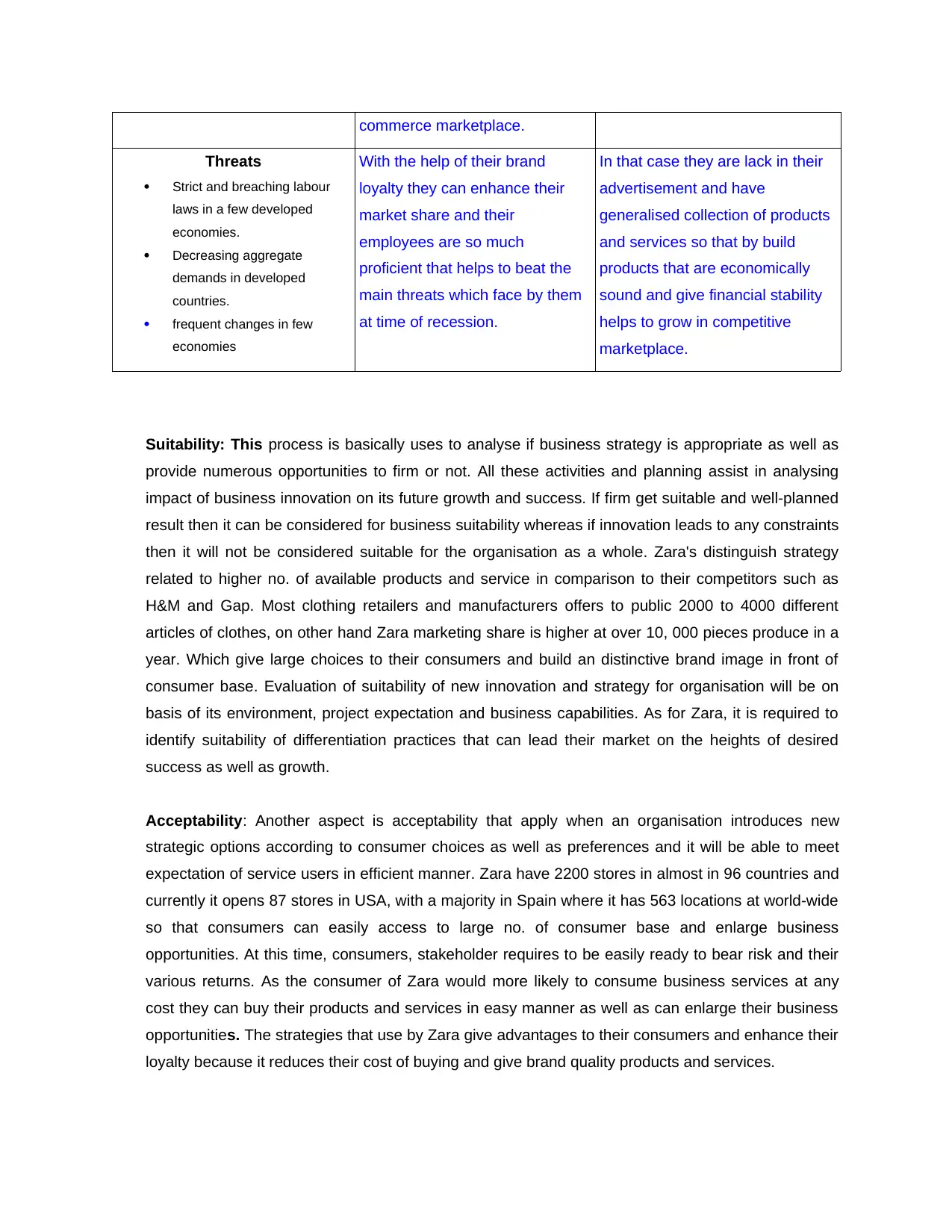
commerce marketplace.
Threats
Strict and breaching labour
laws in a few developed
economies.
Decreasing aggregate
demands in developed
countries.
frequent changes in few
economies
With the help of their brand
loyalty they can enhance their
market share and their
employees are so much
proficient that helps to beat the
main threats which face by them
at time of recession.
In that case they are lack in their
advertisement and have
generalised collection of products
and services so that by build
products that are economically
sound and give financial stability
helps to grow in competitive
marketplace.
Suitability: This process is basically uses to analyse if business strategy is appropriate as well as
provide numerous opportunities to firm or not. All these activities and planning assist in analysing
impact of business innovation on its future growth and success. If firm get suitable and well-planned
result then it can be considered for business suitability whereas if innovation leads to any constraints
then it will not be considered suitable for the organisation as a whole. Zara's distinguish strategy
related to higher no. of available products and service in comparison to their competitors such as
H&M and Gap. Most clothing retailers and manufacturers offers to public 2000 to 4000 different
articles of clothes, on other hand Zara marketing share is higher at over 10, 000 pieces produce in a
year. Which give large choices to their consumers and build an distinctive brand image in front of
consumer base. Evaluation of suitability of new innovation and strategy for organisation will be on
basis of its environment, project expectation and business capabilities. As for Zara, it is required to
identify suitability of differentiation practices that can lead their market on the heights of desired
success as well as growth.
Acceptability: Another aspect is acceptability that apply when an organisation introduces new
strategic options according to consumer choices as well as preferences and it will be able to meet
expectation of service users in efficient manner. Zara have 2200 stores in almost in 96 countries and
currently it opens 87 stores in USA, with a majority in Spain where it has 563 locations at world-wide
so that consumers can easily access to large no. of consumer base and enlarge business
opportunities. At this time, consumers, stakeholder requires to be easily ready to bear risk and their
various returns. As the consumer of Zara would more likely to consume business services at any
cost they can buy their products and services in easy manner as well as can enlarge their business
opportunities. The strategies that use by Zara give advantages to their consumers and enhance their
loyalty because it reduces their cost of buying and give brand quality products and services.
Threats
Strict and breaching labour
laws in a few developed
economies.
Decreasing aggregate
demands in developed
countries.
frequent changes in few
economies
With the help of their brand
loyalty they can enhance their
market share and their
employees are so much
proficient that helps to beat the
main threats which face by them
at time of recession.
In that case they are lack in their
advertisement and have
generalised collection of products
and services so that by build
products that are economically
sound and give financial stability
helps to grow in competitive
marketplace.
Suitability: This process is basically uses to analyse if business strategy is appropriate as well as
provide numerous opportunities to firm or not. All these activities and planning assist in analysing
impact of business innovation on its future growth and success. If firm get suitable and well-planned
result then it can be considered for business suitability whereas if innovation leads to any constraints
then it will not be considered suitable for the organisation as a whole. Zara's distinguish strategy
related to higher no. of available products and service in comparison to their competitors such as
H&M and Gap. Most clothing retailers and manufacturers offers to public 2000 to 4000 different
articles of clothes, on other hand Zara marketing share is higher at over 10, 000 pieces produce in a
year. Which give large choices to their consumers and build an distinctive brand image in front of
consumer base. Evaluation of suitability of new innovation and strategy for organisation will be on
basis of its environment, project expectation and business capabilities. As for Zara, it is required to
identify suitability of differentiation practices that can lead their market on the heights of desired
success as well as growth.
Acceptability: Another aspect is acceptability that apply when an organisation introduces new
strategic options according to consumer choices as well as preferences and it will be able to meet
expectation of service users in efficient manner. Zara have 2200 stores in almost in 96 countries and
currently it opens 87 stores in USA, with a majority in Spain where it has 563 locations at world-wide
so that consumers can easily access to large no. of consumer base and enlarge business
opportunities. At this time, consumers, stakeholder requires to be easily ready to bear risk and their
various returns. As the consumer of Zara would more likely to consume business services at any
cost they can buy their products and services in easy manner as well as can enlarge their business
opportunities. The strategies that use by Zara give advantages to their consumers and enhance their
loyalty because it reduces their cost of buying and give brand quality products and services.
Paraphrase This Document
Need a fresh take? Get an instant paraphrase of this document with our AI Paraphraser
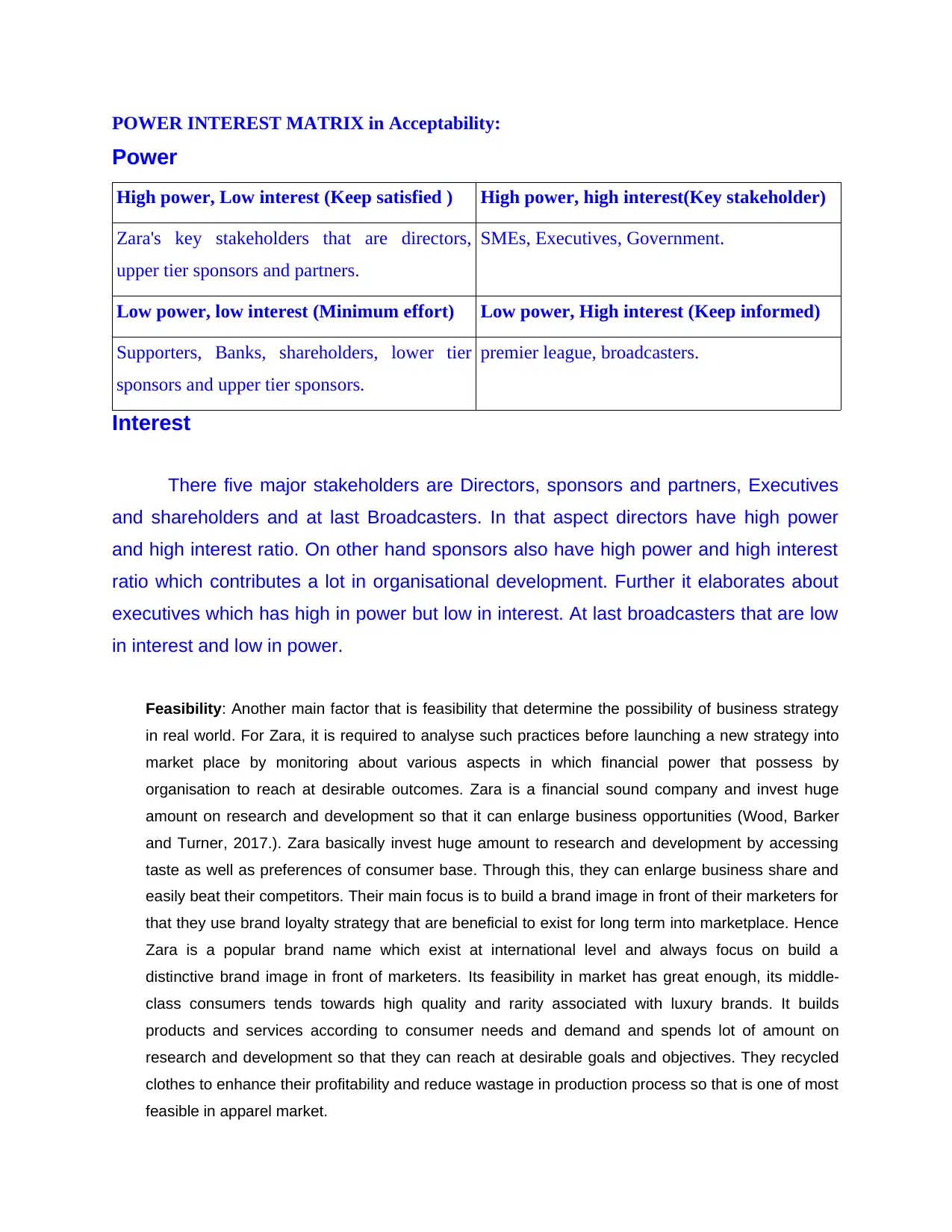
POWER INTEREST MATRIX in Acceptability:
Power
High power, Low interest (Keep satisfied ) High power, high interest(Key stakeholder)
Zara's key stakeholders that are directors,
upper tier sponsors and partners.
SMEs, Executives, Government.
Low power, low interest (Minimum effort) Low power, High interest (Keep informed)
Supporters, Banks, shareholders, lower tier
sponsors and upper tier sponsors.
premier league, broadcasters.
Interest
There five major stakeholders are Directors, sponsors and partners, Executives
and shareholders and at last Broadcasters. In that aspect directors have high power
and high interest ratio. On other hand sponsors also have high power and high interest
ratio which contributes a lot in organisational development. Further it elaborates about
executives which has high in power but low in interest. At last broadcasters that are low
in interest and low in power.
Feasibility: Another main factor that is feasibility that determine the possibility of business strategy
in real world. For Zara, it is required to analyse such practices before launching a new strategy into
market place by monitoring about various aspects in which financial power that possess by
organisation to reach at desirable outcomes. Zara is a financial sound company and invest huge
amount on research and development so that it can enlarge business opportunities (Wood, Barker
and Turner, 2017.). Zara basically invest huge amount to research and development by accessing
taste as well as preferences of consumer base. Through this, they can enlarge business share and
easily beat their competitors. Their main focus is to build a brand image in front of their marketers for
that they use brand loyalty strategy that are beneficial to exist for long term into marketplace. Hence
Zara is a popular brand name which exist at international level and always focus on build a
distinctive brand image in front of marketers. Its feasibility in market has great enough, its middle-
class consumers tends towards high quality and rarity associated with luxury brands. It builds
products and services according to consumer needs and demand and spends lot of amount on
research and development so that they can reach at desirable goals and objectives. They recycled
clothes to enhance their profitability and reduce wastage in production process so that is one of most
feasible in apparel market.
Power
High power, Low interest (Keep satisfied ) High power, high interest(Key stakeholder)
Zara's key stakeholders that are directors,
upper tier sponsors and partners.
SMEs, Executives, Government.
Low power, low interest (Minimum effort) Low power, High interest (Keep informed)
Supporters, Banks, shareholders, lower tier
sponsors and upper tier sponsors.
premier league, broadcasters.
Interest
There five major stakeholders are Directors, sponsors and partners, Executives
and shareholders and at last Broadcasters. In that aspect directors have high power
and high interest ratio. On other hand sponsors also have high power and high interest
ratio which contributes a lot in organisational development. Further it elaborates about
executives which has high in power but low in interest. At last broadcasters that are low
in interest and low in power.
Feasibility: Another main factor that is feasibility that determine the possibility of business strategy
in real world. For Zara, it is required to analyse such practices before launching a new strategy into
market place by monitoring about various aspects in which financial power that possess by
organisation to reach at desirable outcomes. Zara is a financial sound company and invest huge
amount on research and development so that it can enlarge business opportunities (Wood, Barker
and Turner, 2017.). Zara basically invest huge amount to research and development by accessing
taste as well as preferences of consumer base. Through this, they can enlarge business share and
easily beat their competitors. Their main focus is to build a brand image in front of their marketers for
that they use brand loyalty strategy that are beneficial to exist for long term into marketplace. Hence
Zara is a popular brand name which exist at international level and always focus on build a
distinctive brand image in front of marketers. Its feasibility in market has great enough, its middle-
class consumers tends towards high quality and rarity associated with luxury brands. It builds
products and services according to consumer needs and demand and spends lot of amount on
research and development so that they can reach at desirable goals and objectives. They recycled
clothes to enhance their profitability and reduce wastage in production process so that is one of most
feasible in apparel market.

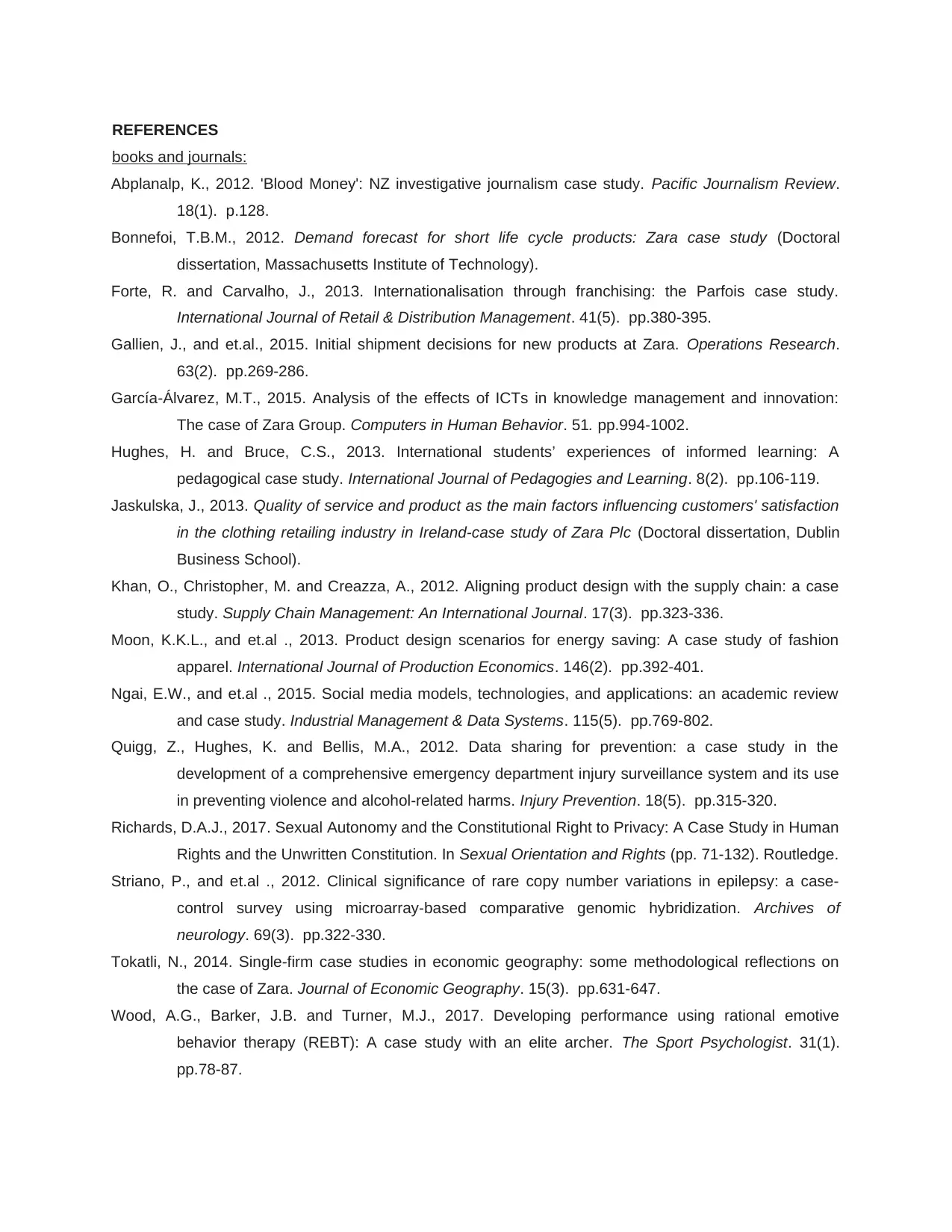
REFERENCES
books and journals:
Abplanalp, K., 2012. 'Blood Money': NZ investigative journalism case study. Pacific Journalism Review.
18(1). p.128.
Bonnefoi, T.B.M., 2012. Demand forecast for short life cycle products: Zara case study (Doctoral
dissertation, Massachusetts Institute of Technology).
Forte, R. and Carvalho, J., 2013. Internationalisation through franchising: the Parfois case study.
International Journal of Retail & Distribution Management. 41(5). pp.380-395.
Gallien, J., and et.al., 2015. Initial shipment decisions for new products at Zara. Operations Research.
63(2). pp.269-286.
García-Álvarez, M.T., 2015. Analysis of the effects of ICTs in knowledge management and innovation:
The case of Zara Group. Computers in Human Behavior. 51. pp.994-1002.
Hughes, H. and Bruce, C.S., 2013. International students’ experiences of informed learning: A
pedagogical case study. International Journal of Pedagogies and Learning. 8(2). pp.106-119.
Jaskulska, J., 2013. Quality of service and product as the main factors influencing customers' satisfaction
in the clothing retailing industry in Ireland-case study of Zara Plc (Doctoral dissertation, Dublin
Business School).
Khan, O., Christopher, M. and Creazza, A., 2012. Aligning product design with the supply chain: a case
study. Supply Chain Management: An International Journal. 17(3). pp.323-336.
Moon, K.K.L., and et.al ., 2013. Product design scenarios for energy saving: A case study of fashion
apparel. International Journal of Production Economics. 146(2). pp.392-401.
Ngai, E.W., and et.al ., 2015. Social media models, technologies, and applications: an academic review
and case study. Industrial Management & Data Systems. 115(5). pp.769-802.
Quigg, Z., Hughes, K. and Bellis, M.A., 2012. Data sharing for prevention: a case study in the
development of a comprehensive emergency department injury surveillance system and its use
in preventing violence and alcohol-related harms. Injury Prevention. 18(5). pp.315-320.
Richards, D.A.J., 2017. Sexual Autonomy and the Constitutional Right to Privacy: A Case Study in Human
Rights and the Unwritten Constitution. In Sexual Orientation and Rights (pp. 71-132). Routledge.
Striano, P., and et.al ., 2012. Clinical significance of rare copy number variations in epilepsy: a case-
control survey using microarray-based comparative genomic hybridization. Archives of
neurology. 69(3). pp.322-330.
Tokatli, N., 2014. Single-firm case studies in economic geography: some methodological reflections on
the case of Zara. Journal of Economic Geography. 15(3). pp.631-647.
Wood, A.G., Barker, J.B. and Turner, M.J., 2017. Developing performance using rational emotive
behavior therapy (REBT): A case study with an elite archer. The Sport Psychologist. 31(1).
pp.78-87.
books and journals:
Abplanalp, K., 2012. 'Blood Money': NZ investigative journalism case study. Pacific Journalism Review.
18(1). p.128.
Bonnefoi, T.B.M., 2012. Demand forecast for short life cycle products: Zara case study (Doctoral
dissertation, Massachusetts Institute of Technology).
Forte, R. and Carvalho, J., 2013. Internationalisation through franchising: the Parfois case study.
International Journal of Retail & Distribution Management. 41(5). pp.380-395.
Gallien, J., and et.al., 2015. Initial shipment decisions for new products at Zara. Operations Research.
63(2). pp.269-286.
García-Álvarez, M.T., 2015. Analysis of the effects of ICTs in knowledge management and innovation:
The case of Zara Group. Computers in Human Behavior. 51. pp.994-1002.
Hughes, H. and Bruce, C.S., 2013. International students’ experiences of informed learning: A
pedagogical case study. International Journal of Pedagogies and Learning. 8(2). pp.106-119.
Jaskulska, J., 2013. Quality of service and product as the main factors influencing customers' satisfaction
in the clothing retailing industry in Ireland-case study of Zara Plc (Doctoral dissertation, Dublin
Business School).
Khan, O., Christopher, M. and Creazza, A., 2012. Aligning product design with the supply chain: a case
study. Supply Chain Management: An International Journal. 17(3). pp.323-336.
Moon, K.K.L., and et.al ., 2013. Product design scenarios for energy saving: A case study of fashion
apparel. International Journal of Production Economics. 146(2). pp.392-401.
Ngai, E.W., and et.al ., 2015. Social media models, technologies, and applications: an academic review
and case study. Industrial Management & Data Systems. 115(5). pp.769-802.
Quigg, Z., Hughes, K. and Bellis, M.A., 2012. Data sharing for prevention: a case study in the
development of a comprehensive emergency department injury surveillance system and its use
in preventing violence and alcohol-related harms. Injury Prevention. 18(5). pp.315-320.
Richards, D.A.J., 2017. Sexual Autonomy and the Constitutional Right to Privacy: A Case Study in Human
Rights and the Unwritten Constitution. In Sexual Orientation and Rights (pp. 71-132). Routledge.
Striano, P., and et.al ., 2012. Clinical significance of rare copy number variations in epilepsy: a case-
control survey using microarray-based comparative genomic hybridization. Archives of
neurology. 69(3). pp.322-330.
Tokatli, N., 2014. Single-firm case studies in economic geography: some methodological reflections on
the case of Zara. Journal of Economic Geography. 15(3). pp.631-647.
Wood, A.G., Barker, J.B. and Turner, M.J., 2017. Developing performance using rational emotive
behavior therapy (REBT): A case study with an elite archer. The Sport Psychologist. 31(1).
pp.78-87.
1 out of 16
Related Documents
Your All-in-One AI-Powered Toolkit for Academic Success.
+13062052269
info@desklib.com
Available 24*7 on WhatsApp / Email
![[object Object]](/_next/static/media/star-bottom.7253800d.svg)
Unlock your academic potential
© 2024 | Zucol Services PVT LTD | All rights reserved.





